Industry/Micro Environment Report: Australian Activewear
VerifiedAdded on 2021/01/19
|28
|7443
|159
Report
AI Summary
This comprehensive report by Group 4 – Fantastic Four provides an in-depth analysis of the Australian activewear industry. It begins with an executive summary highlighting the industry's growth, driven by the athleisure trend and consumer demand for sustainable products. The report then delves into a detailed industry overview, followed by a PESTEL analysis, examining political, economic, legal, demographic, social, environmental, and technological factors impacting the market. Further sections include competitor and collaborator analyses, customer analysis, and key success factors. The report emphasizes the importance of eco-friendly practices and personalized customer service for future growth, projecting significant revenue increases by 2024. The report uses figures, tables, and analysis to provide a thorough understanding of the market, its challenges, and opportunities, making it a valuable resource for anyone interested in the Australian activewear sector.
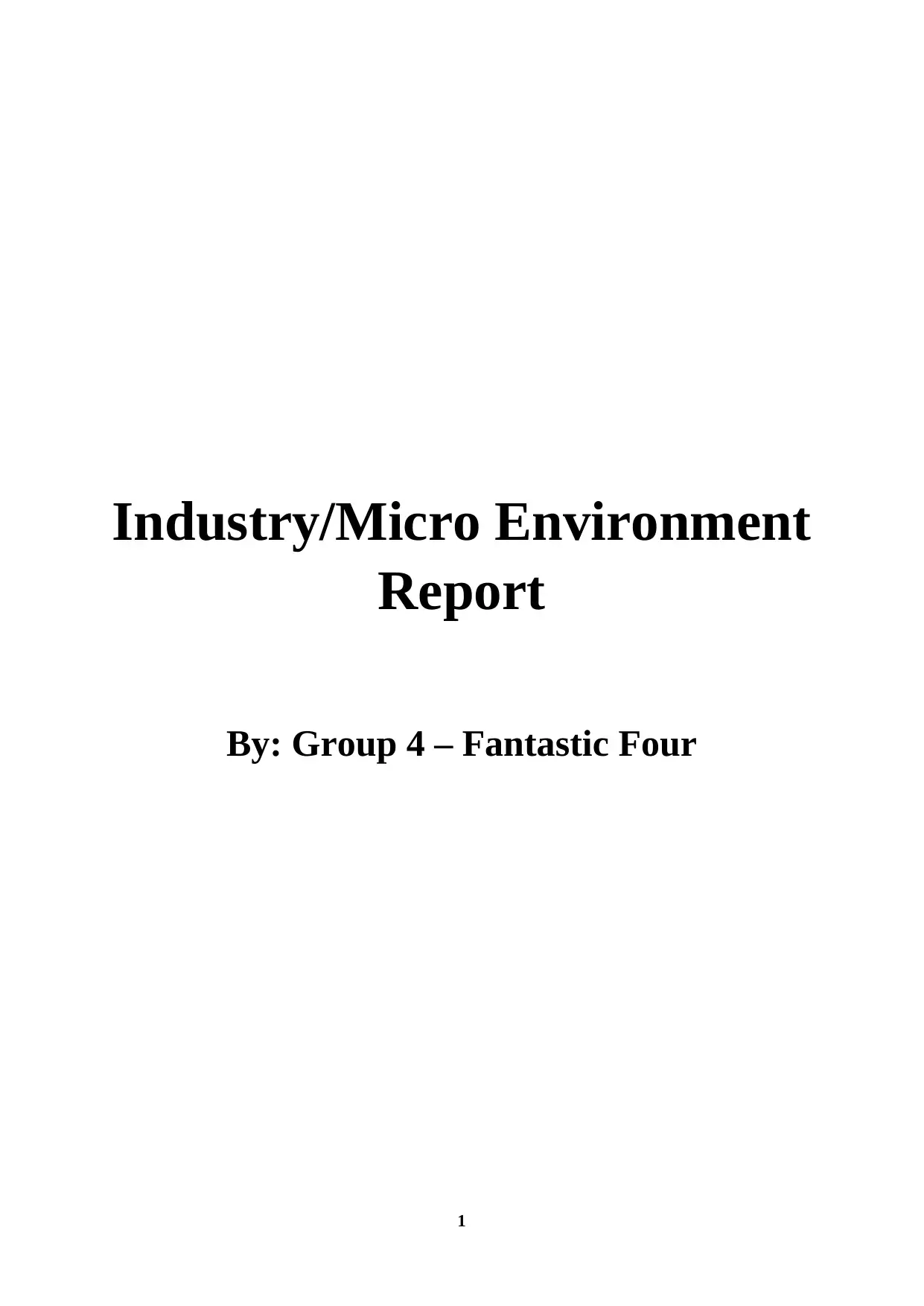
1
Industry/Micro Environment
Report
By: Group 4 – Fantastic Four
Industry/Micro Environment
Report
By: Group 4 – Fantastic Four
Paraphrase This Document
Need a fresh take? Get an instant paraphrase of this document with our AI Paraphraser
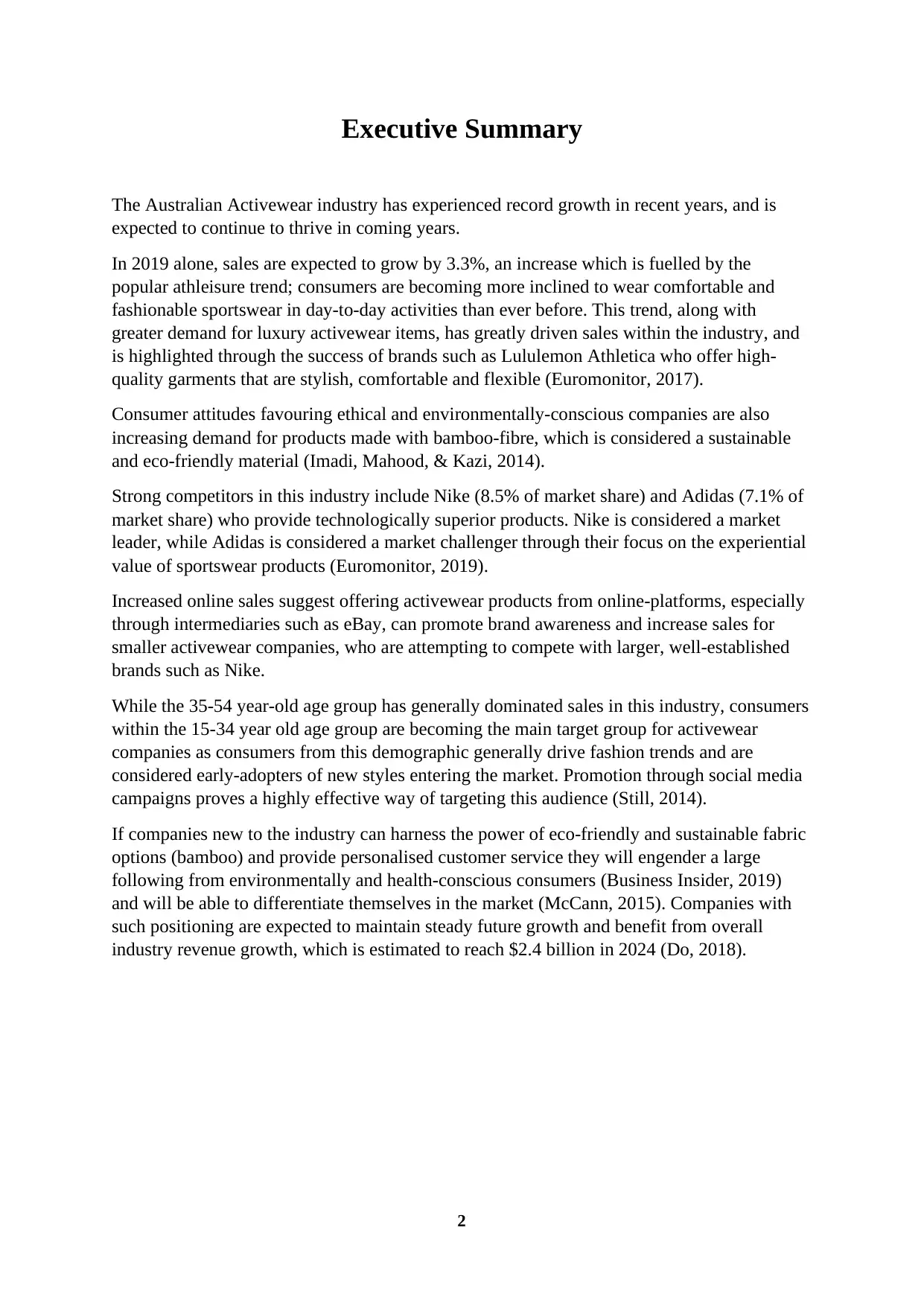
2
Executive Summary
The Australian Activewear industry has experienced record growth in recent years, and is
expected to continue to thrive in coming years.
In 2019 alone, sales are expected to grow by 3.3%, an increase which is fuelled by the
popular athleisure trend; consumers are becoming more inclined to wear comfortable and
fashionable sportswear in day-to-day activities than ever before. This trend, along with
greater demand for luxury activewear items, has greatly driven sales within the industry, and
is highlighted through the success of brands such as Lululemon Athletica who offer high-
quality garments that are stylish, comfortable and flexible (Euromonitor, 2017).
Consumer attitudes favouring ethical and environmentally-conscious companies are also
increasing demand for products made with bamboo-fibre, which is considered a sustainable
and eco-friendly material (Imadi, Mahood, & Kazi, 2014).
Strong competitors in this industry include Nike (8.5% of market share) and Adidas (7.1% of
market share) who provide technologically superior products. Nike is considered a market
leader, while Adidas is considered a market challenger through their focus on the experiential
value of sportswear products (Euromonitor, 2019).
Increased online sales suggest offering activewear products from online-platforms, especially
through intermediaries such as eBay, can promote brand awareness and increase sales for
smaller activewear companies, who are attempting to compete with larger, well-established
brands such as Nike.
While the 35-54 year-old age group has generally dominated sales in this industry, consumers
within the 15-34 year old age group are becoming the main target group for activewear
companies as consumers from this demographic generally drive fashion trends and are
considered early-adopters of new styles entering the market. Promotion through social media
campaigns proves a highly effective way of targeting this audience (Still, 2014).
If companies new to the industry can harness the power of eco-friendly and sustainable fabric
options (bamboo) and provide personalised customer service they will engender a large
following from environmentally and health-conscious consumers (Business Insider, 2019)
and will be able to differentiate themselves in the market (McCann, 2015). Companies with
such positioning are expected to maintain steady future growth and benefit from overall
industry revenue growth, which is estimated to reach $2.4 billion in 2024 (Do, 2018).
Executive Summary
The Australian Activewear industry has experienced record growth in recent years, and is
expected to continue to thrive in coming years.
In 2019 alone, sales are expected to grow by 3.3%, an increase which is fuelled by the
popular athleisure trend; consumers are becoming more inclined to wear comfortable and
fashionable sportswear in day-to-day activities than ever before. This trend, along with
greater demand for luxury activewear items, has greatly driven sales within the industry, and
is highlighted through the success of brands such as Lululemon Athletica who offer high-
quality garments that are stylish, comfortable and flexible (Euromonitor, 2017).
Consumer attitudes favouring ethical and environmentally-conscious companies are also
increasing demand for products made with bamboo-fibre, which is considered a sustainable
and eco-friendly material (Imadi, Mahood, & Kazi, 2014).
Strong competitors in this industry include Nike (8.5% of market share) and Adidas (7.1% of
market share) who provide technologically superior products. Nike is considered a market
leader, while Adidas is considered a market challenger through their focus on the experiential
value of sportswear products (Euromonitor, 2019).
Increased online sales suggest offering activewear products from online-platforms, especially
through intermediaries such as eBay, can promote brand awareness and increase sales for
smaller activewear companies, who are attempting to compete with larger, well-established
brands such as Nike.
While the 35-54 year-old age group has generally dominated sales in this industry, consumers
within the 15-34 year old age group are becoming the main target group for activewear
companies as consumers from this demographic generally drive fashion trends and are
considered early-adopters of new styles entering the market. Promotion through social media
campaigns proves a highly effective way of targeting this audience (Still, 2014).
If companies new to the industry can harness the power of eco-friendly and sustainable fabric
options (bamboo) and provide personalised customer service they will engender a large
following from environmentally and health-conscious consumers (Business Insider, 2019)
and will be able to differentiate themselves in the market (McCann, 2015). Companies with
such positioning are expected to maintain steady future growth and benefit from overall
industry revenue growth, which is estimated to reach $2.4 billion in 2024 (Do, 2018).
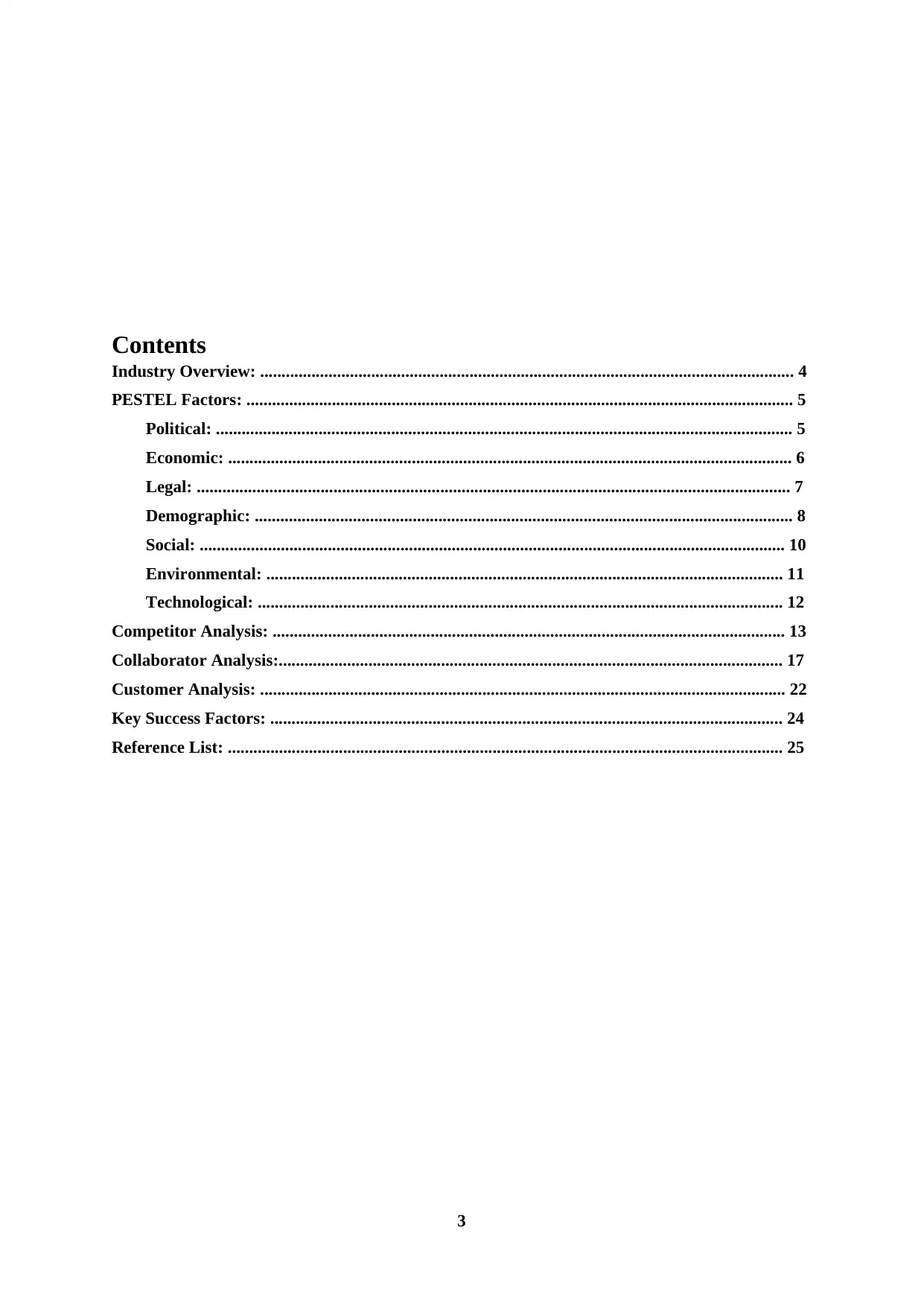
3
Contents
Industry Overview: ............................................................................................................................. 4
PESTEL Factors: ................................................................................................................................ 5
Political: ....................................................................................................................................... 5
Economic: .................................................................................................................................... 6
Legal: ........................................................................................................................................... 7
Demographic: .............................................................................................................................. 8
Social: ......................................................................................................................................... 10
Environmental: ......................................................................................................................... 11
Technological: ........................................................................................................................... 12
Competitor Analysis: ........................................................................................................................ 13
Collaborator Analysis:...................................................................................................................... 17
Customer Analysis: ........................................................................................................................... 22
Key Success Factors: ........................................................................................................................ 24
Reference List: .................................................................................................................................. 25
Contents
Industry Overview: ............................................................................................................................. 4
PESTEL Factors: ................................................................................................................................ 5
Political: ....................................................................................................................................... 5
Economic: .................................................................................................................................... 6
Legal: ........................................................................................................................................... 7
Demographic: .............................................................................................................................. 8
Social: ......................................................................................................................................... 10
Environmental: ......................................................................................................................... 11
Technological: ........................................................................................................................... 12
Competitor Analysis: ........................................................................................................................ 13
Collaborator Analysis:...................................................................................................................... 17
Customer Analysis: ........................................................................................................................... 22
Key Success Factors: ........................................................................................................................ 24
Reference List: .................................................................................................................................. 25
⊘ This is a preview!⊘
Do you want full access?
Subscribe today to unlock all pages.

Trusted by 1+ million students worldwide
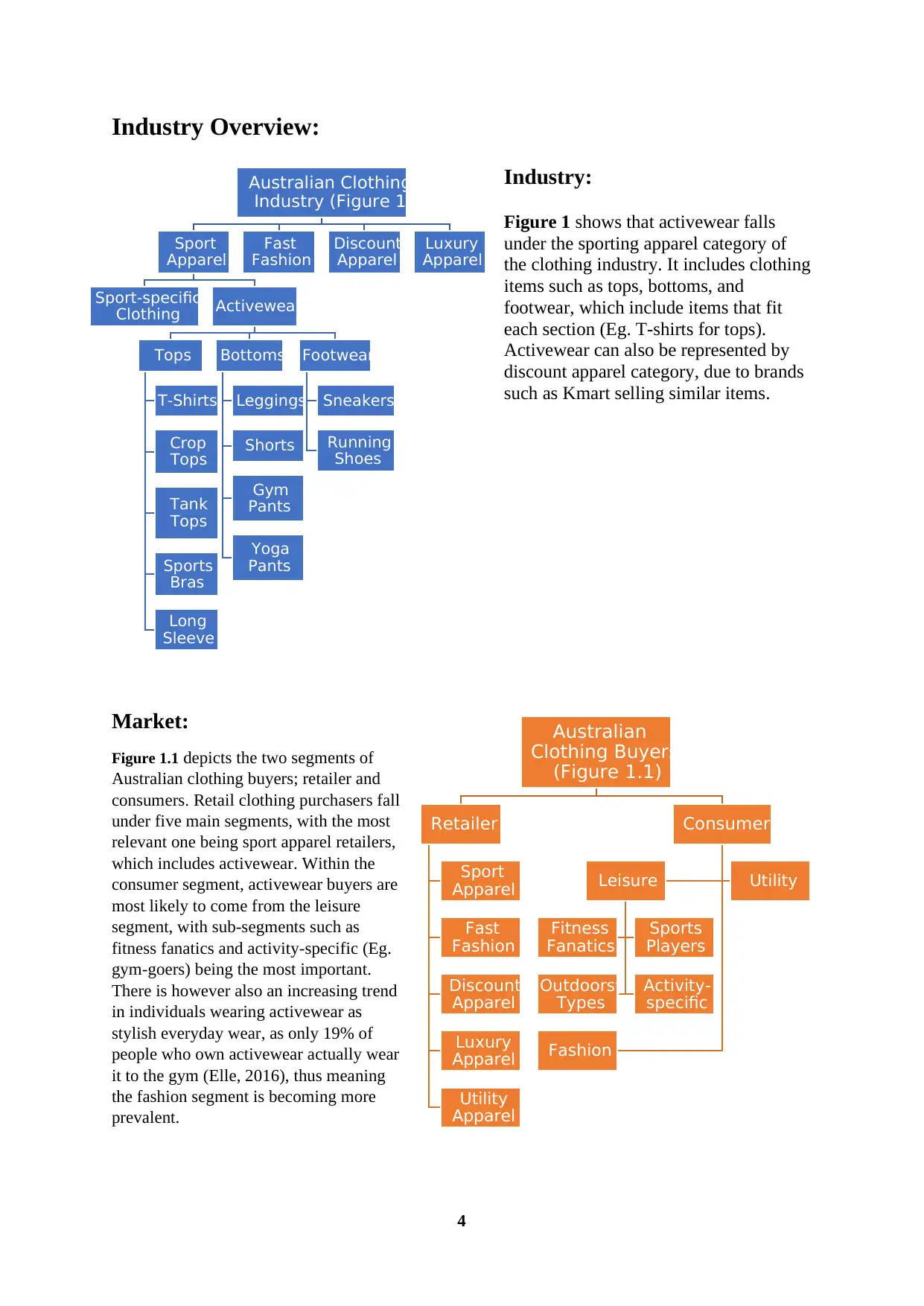
4
Industry Overview:
Industry:
Figure 1 shows that activewear falls
under the sporting apparel category of
the clothing industry. It includes clothing
items such as tops, bottoms, and
footwear, which include items that fit
each section (Eg. T-shirts for tops).
Activewear can also be represented by
discount apparel category, due to brands
such as Kmart selling similar items.
Market:
Figure 1.1 depicts the two segments of
Australian clothing buyers; retailer and
consumers. Retail clothing purchasers fall
under five main segments, with the most
relevant one being sport apparel retailers,
which includes activewear. Within the
consumer segment, activewear buyers are
most likely to come from the leisure
segment, with sub-segments such as
fitness fanatics and activity-specific (Eg.
gym-goers) being the most important.
There is however also an increasing trend
in individuals wearing activewear as
stylish everyday wear, as only 19% of
people who own activewear actually wear
it to the gym (Elle, 2016), thus meaning
the fashion segment is becoming more
prevalent.
Australian Clothing
Industry (Figure 1)
Sport
Apparel
Sport-specific
Clothing Activewear
Tops
T-Shirts
Crop
Tops
Tank
Tops
Sports
Bras
Long
Sleeve
Bottoms
Leggings
Shorts
Gym
Pants
Yoga
Pants
Footwear
Sneakers
Running
Shoes
Fast
Fashion
Discount
Apparel
Luxury
Apparel
Australian
Clothing Buyers
(Figure 1.1)
Retailer
Sport
Apparel
Fast
Fashion
Discount
Apparel
Luxury
Apparel
Utility
Apparel
Consumer
Leisure
Fitness
Fanatics
Sports
Players
Outdoorsy
Types
Activity-
specific
Utility
Fashion
Industry Overview:
Industry:
Figure 1 shows that activewear falls
under the sporting apparel category of
the clothing industry. It includes clothing
items such as tops, bottoms, and
footwear, which include items that fit
each section (Eg. T-shirts for tops).
Activewear can also be represented by
discount apparel category, due to brands
such as Kmart selling similar items.
Market:
Figure 1.1 depicts the two segments of
Australian clothing buyers; retailer and
consumers. Retail clothing purchasers fall
under five main segments, with the most
relevant one being sport apparel retailers,
which includes activewear. Within the
consumer segment, activewear buyers are
most likely to come from the leisure
segment, with sub-segments such as
fitness fanatics and activity-specific (Eg.
gym-goers) being the most important.
There is however also an increasing trend
in individuals wearing activewear as
stylish everyday wear, as only 19% of
people who own activewear actually wear
it to the gym (Elle, 2016), thus meaning
the fashion segment is becoming more
prevalent.
Australian Clothing
Industry (Figure 1)
Sport
Apparel
Sport-specific
Clothing Activewear
Tops
T-Shirts
Crop
Tops
Tank
Tops
Sports
Bras
Long
Sleeve
Bottoms
Leggings
Shorts
Gym
Pants
Yoga
Pants
Footwear
Sneakers
Running
Shoes
Fast
Fashion
Discount
Apparel
Luxury
Apparel
Australian
Clothing Buyers
(Figure 1.1)
Retailer
Sport
Apparel
Fast
Fashion
Discount
Apparel
Luxury
Apparel
Utility
Apparel
Consumer
Leisure
Fitness
Fanatics
Sports
Players
Outdoorsy
Types
Activity-
specific
Utility
Fashion
Paraphrase This Document
Need a fresh take? Get an instant paraphrase of this document with our AI Paraphraser
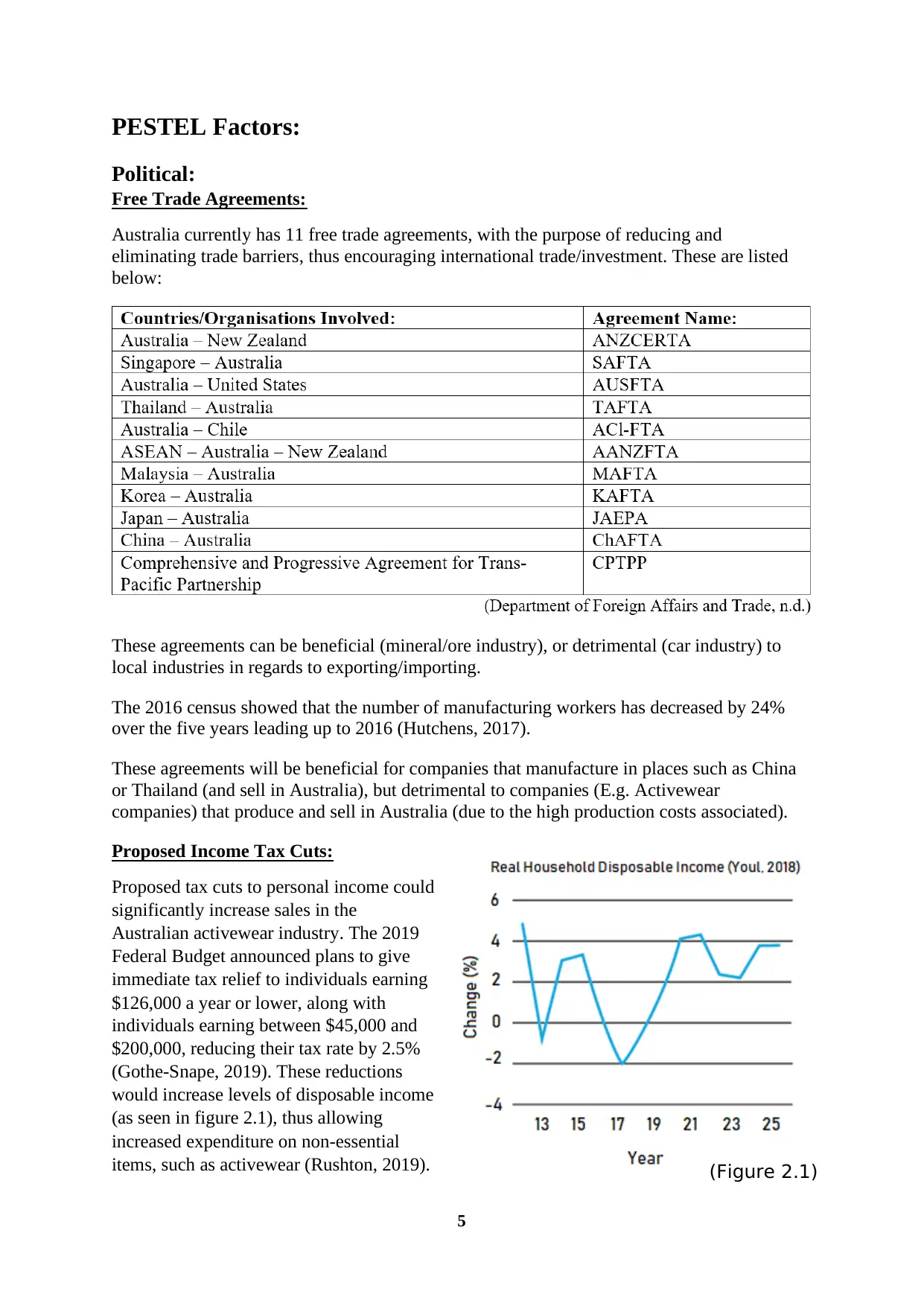
5
PESTEL Factors:
Political:
Free Trade Agreements:
Australia currently has 11 free trade agreements, with the purpose of reducing and
eliminating trade barriers, thus encouraging international trade/investment. These are listed
below:
These agreements can be beneficial (mineral/ore industry), or detrimental (car industry) to
local industries in regards to exporting/importing.
The 2016 census showed that the number of manufacturing workers has decreased by 24%
over the five years leading up to 2016 (Hutchens, 2017).
These agreements will be beneficial for companies that manufacture in places such as China
or Thailand (and sell in Australia), but detrimental to companies (E.g. Activewear
companies) that produce and sell in Australia (due to the high production costs associated).
Proposed Income Tax Cuts:
Proposed tax cuts to personal income could
significantly increase sales in the
Australian activewear industry. The 2019
Federal Budget announced plans to give
immediate tax relief to individuals earning
$126,000 a year or lower, along with
individuals earning between $45,000 and
$200,000, reducing their tax rate by 2.5%
(Gothe-Snape, 2019). These reductions
would increase levels of disposable income
(as seen in figure 2.1), thus allowing
increased expenditure on non-essential
items, such as activewear (Rushton, 2019). (Figure 2.1)
PESTEL Factors:
Political:
Free Trade Agreements:
Australia currently has 11 free trade agreements, with the purpose of reducing and
eliminating trade barriers, thus encouraging international trade/investment. These are listed
below:
These agreements can be beneficial (mineral/ore industry), or detrimental (car industry) to
local industries in regards to exporting/importing.
The 2016 census showed that the number of manufacturing workers has decreased by 24%
over the five years leading up to 2016 (Hutchens, 2017).
These agreements will be beneficial for companies that manufacture in places such as China
or Thailand (and sell in Australia), but detrimental to companies (E.g. Activewear
companies) that produce and sell in Australia (due to the high production costs associated).
Proposed Income Tax Cuts:
Proposed tax cuts to personal income could
significantly increase sales in the
Australian activewear industry. The 2019
Federal Budget announced plans to give
immediate tax relief to individuals earning
$126,000 a year or lower, along with
individuals earning between $45,000 and
$200,000, reducing their tax rate by 2.5%
(Gothe-Snape, 2019). These reductions
would increase levels of disposable income
(as seen in figure 2.1), thus allowing
increased expenditure on non-essential
items, such as activewear (Rushton, 2019). (Figure 2.1)
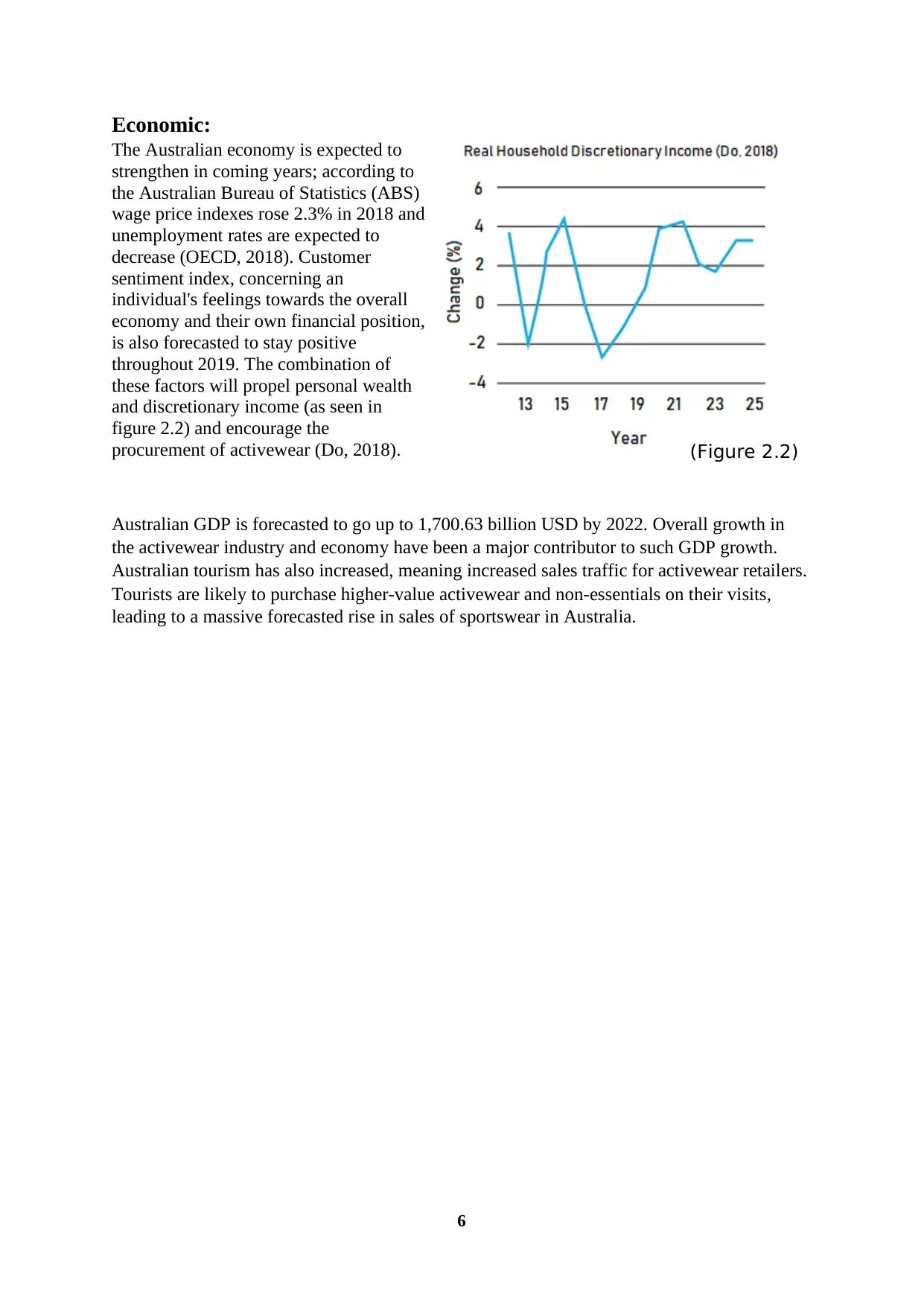
6
Economic:
The Australian economy is expected to
strengthen in coming years; according to
the Australian Bureau of Statistics (ABS)
wage price indexes rose 2.3% in 2018 and
unemployment rates are expected to
decrease (OECD, 2018). Customer
sentiment index, concerning an
individual's feelings towards the overall
economy and their own financial position,
is also forecasted to stay positive
throughout 2019. The combination of
these factors will propel personal wealth
and discretionary income (as seen in
figure 2.2) and encourage the
procurement of activewear (Do, 2018).
Australian GDP is forecasted to go up to 1,700.63 billion USD by 2022. Overall growth in
the activewear industry and economy have been a major contributor to such GDP growth.
Australian tourism has also increased, meaning increased sales traffic for activewear retailers.
Tourists are likely to purchase higher-value activewear and non-essentials on their visits,
leading to a massive forecasted rise in sales of sportswear in Australia.
(Figure 2.2)
Economic:
The Australian economy is expected to
strengthen in coming years; according to
the Australian Bureau of Statistics (ABS)
wage price indexes rose 2.3% in 2018 and
unemployment rates are expected to
decrease (OECD, 2018). Customer
sentiment index, concerning an
individual's feelings towards the overall
economy and their own financial position,
is also forecasted to stay positive
throughout 2019. The combination of
these factors will propel personal wealth
and discretionary income (as seen in
figure 2.2) and encourage the
procurement of activewear (Do, 2018).
Australian GDP is forecasted to go up to 1,700.63 billion USD by 2022. Overall growth in
the activewear industry and economy have been a major contributor to such GDP growth.
Australian tourism has also increased, meaning increased sales traffic for activewear retailers.
Tourists are likely to purchase higher-value activewear and non-essentials on their visits,
leading to a massive forecasted rise in sales of sportswear in Australia.
(Figure 2.2)
⊘ This is a preview!⊘
Do you want full access?
Subscribe today to unlock all pages.

Trusted by 1+ million students worldwide
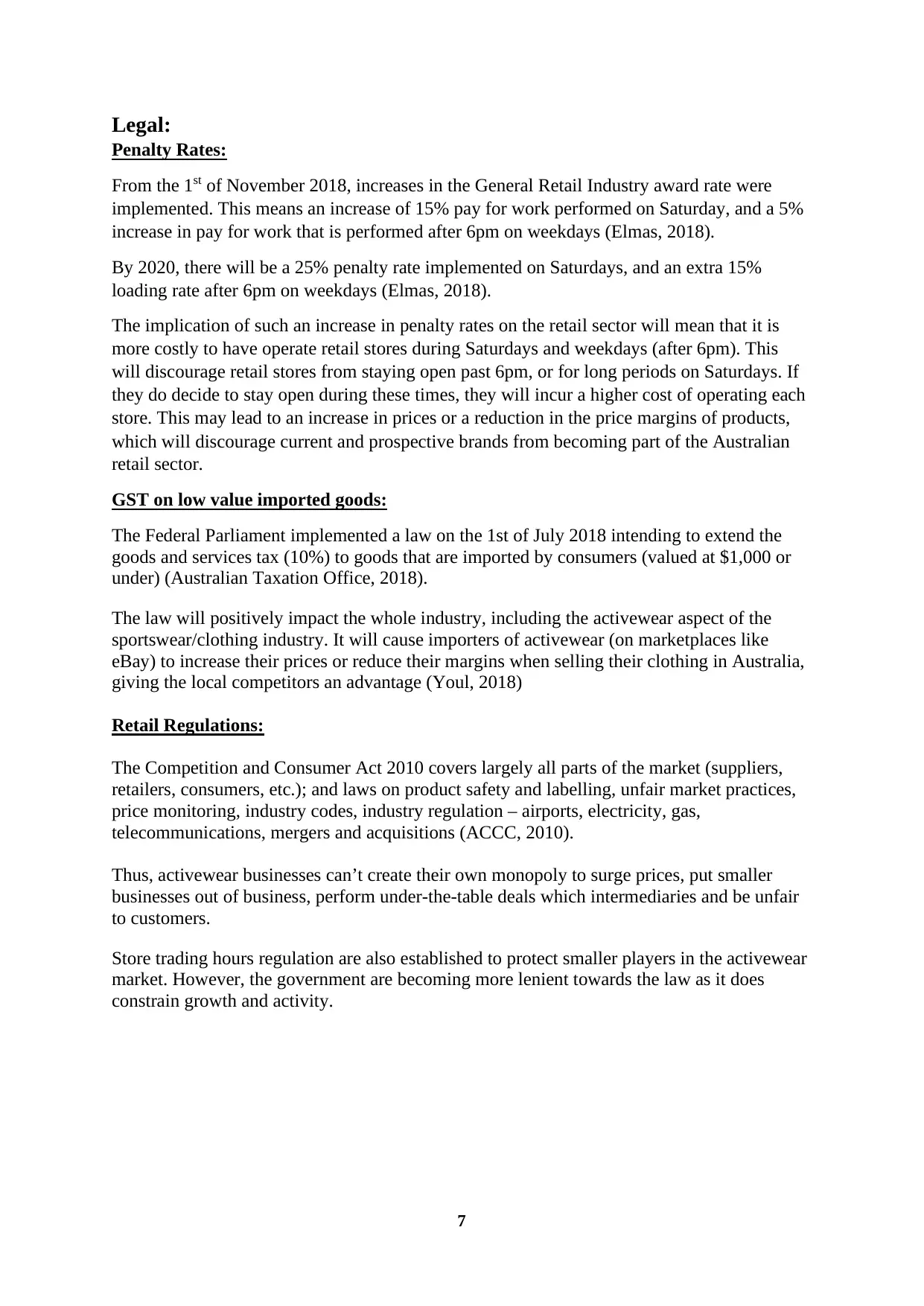
7
Legal:
Penalty Rates:
From the 1st of November 2018, increases in the General Retail Industry award rate were
implemented. This means an increase of 15% pay for work performed on Saturday, and a 5%
increase in pay for work that is performed after 6pm on weekdays (Elmas, 2018).
By 2020, there will be a 25% penalty rate implemented on Saturdays, and an extra 15%
loading rate after 6pm on weekdays (Elmas, 2018).
The implication of such an increase in penalty rates on the retail sector will mean that it is
more costly to have operate retail stores during Saturdays and weekdays (after 6pm). This
will discourage retail stores from staying open past 6pm, or for long periods on Saturdays. If
they do decide to stay open during these times, they will incur a higher cost of operating each
store. This may lead to an increase in prices or a reduction in the price margins of products,
which will discourage current and prospective brands from becoming part of the Australian
retail sector.
GST on low value imported goods:
The Federal Parliament implemented a law on the 1st of July 2018 intending to extend the
goods and services tax (10%) to goods that are imported by consumers (valued at $1,000 or
under) (Australian Taxation Office, 2018).
The law will positively impact the whole industry, including the activewear aspect of the
sportswear/clothing industry. It will cause importers of activewear (on marketplaces like
eBay) to increase their prices or reduce their margins when selling their clothing in Australia,
giving the local competitors an advantage (Youl, 2018)
Retail Regulations:
The Competition and Consumer Act 2010 covers largely all parts of the market (suppliers,
retailers, consumers, etc.); and laws on product safety and labelling, unfair market practices,
price monitoring, industry codes, industry regulation – airports, electricity, gas,
telecommunications, mergers and acquisitions (ACCC, 2010).
Thus, activewear businesses can’t create their own monopoly to surge prices, put smaller
businesses out of business, perform under-the-table deals which intermediaries and be unfair
to customers.
Store trading hours regulation are also established to protect smaller players in the activewear
market. However, the government are becoming more lenient towards the law as it does
constrain growth and activity.
Legal:
Penalty Rates:
From the 1st of November 2018, increases in the General Retail Industry award rate were
implemented. This means an increase of 15% pay for work performed on Saturday, and a 5%
increase in pay for work that is performed after 6pm on weekdays (Elmas, 2018).
By 2020, there will be a 25% penalty rate implemented on Saturdays, and an extra 15%
loading rate after 6pm on weekdays (Elmas, 2018).
The implication of such an increase in penalty rates on the retail sector will mean that it is
more costly to have operate retail stores during Saturdays and weekdays (after 6pm). This
will discourage retail stores from staying open past 6pm, or for long periods on Saturdays. If
they do decide to stay open during these times, they will incur a higher cost of operating each
store. This may lead to an increase in prices or a reduction in the price margins of products,
which will discourage current and prospective brands from becoming part of the Australian
retail sector.
GST on low value imported goods:
The Federal Parliament implemented a law on the 1st of July 2018 intending to extend the
goods and services tax (10%) to goods that are imported by consumers (valued at $1,000 or
under) (Australian Taxation Office, 2018).
The law will positively impact the whole industry, including the activewear aspect of the
sportswear/clothing industry. It will cause importers of activewear (on marketplaces like
eBay) to increase their prices or reduce their margins when selling their clothing in Australia,
giving the local competitors an advantage (Youl, 2018)
Retail Regulations:
The Competition and Consumer Act 2010 covers largely all parts of the market (suppliers,
retailers, consumers, etc.); and laws on product safety and labelling, unfair market practices,
price monitoring, industry codes, industry regulation – airports, electricity, gas,
telecommunications, mergers and acquisitions (ACCC, 2010).
Thus, activewear businesses can’t create their own monopoly to surge prices, put smaller
businesses out of business, perform under-the-table deals which intermediaries and be unfair
to customers.
Store trading hours regulation are also established to protect smaller players in the activewear
market. However, the government are becoming more lenient towards the law as it does
constrain growth and activity.
Paraphrase This Document
Need a fresh take? Get an instant paraphrase of this document with our AI Paraphraser
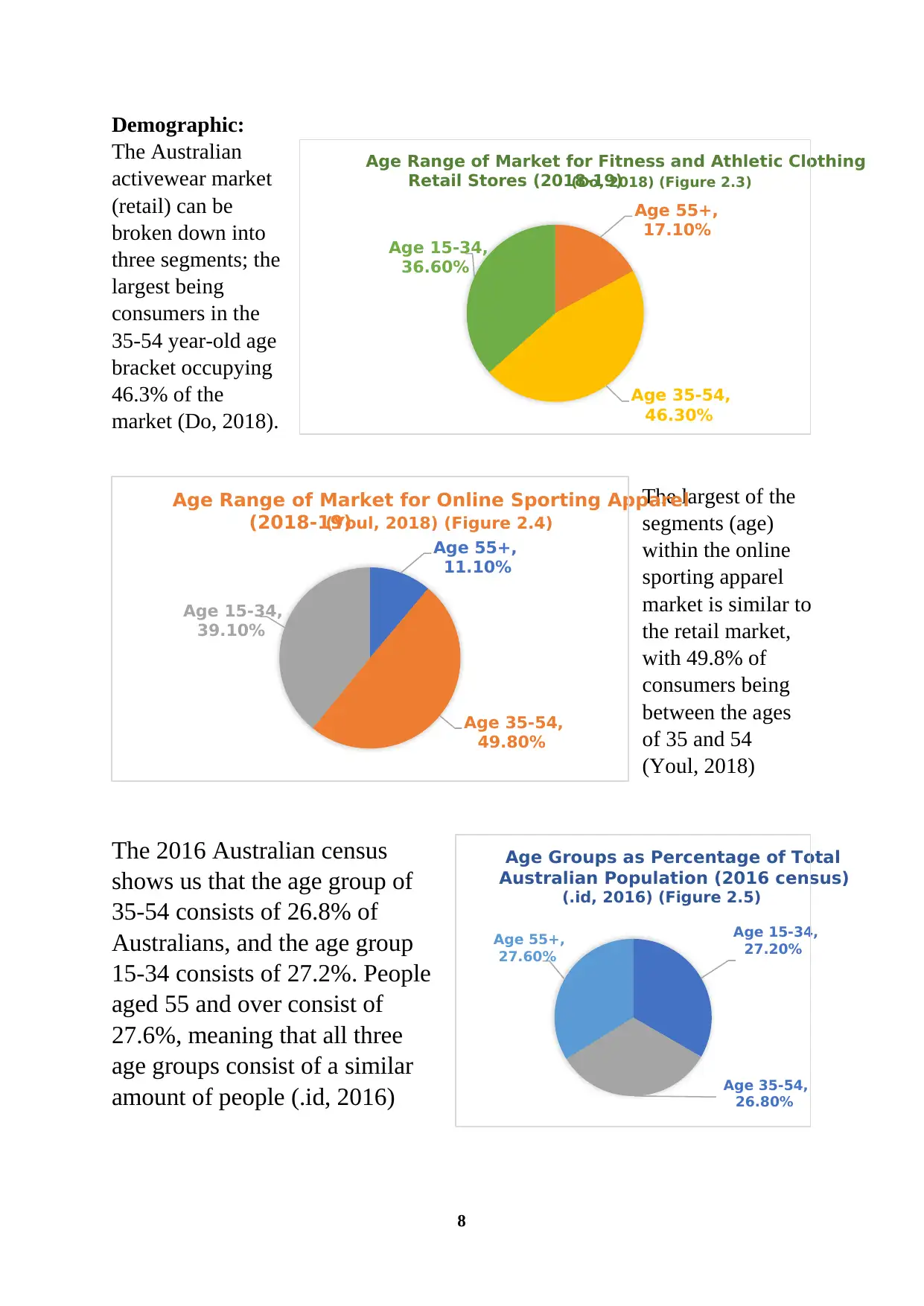
8
Demographic:
The Australian
activewear market
(retail) can be
broken down into
three segments; the
largest being
consumers in the
35-54 year-old age
bracket occupying
46.3% of the
market (Do, 2018).
The largest of the
segments (age)
within the online
sporting apparel
market is similar to
the retail market,
with 49.8% of
consumers being
between the ages
of 35 and 54
(Youl, 2018)
The 2016 Australian census
shows us that the age group of
35-54 consists of 26.8% of
Australians, and the age group
15-34 consists of 27.2%. People
aged 55 and over consist of
27.6%, meaning that all three
age groups consist of a similar
amount of people (.id, 2016)
Age 55+,
17.10%
Age 35-54,
46.30%
Age 15-34,
36.60%
Age Range of Market for Fitness and Athletic Clothing
Retail Stores (2018-19)(Do, 2018) (Figure 2.3)
Age 55+,
11.10%
Age 35-54,
49.80%
Age 15-34,
39.10%
Age Range of Market for Online Sporting Apparel
(2018-19)(Youl, 2018) (Figure 2.4)
Age 15-34,
27.20%
Age 35-54,
26.80%
Age 55+,
27.60%
Age Groups as Percentage of Total
Australian Population (2016 census)
(.id, 2016) (Figure 2.5)
Demographic:
The Australian
activewear market
(retail) can be
broken down into
three segments; the
largest being
consumers in the
35-54 year-old age
bracket occupying
46.3% of the
market (Do, 2018).
The largest of the
segments (age)
within the online
sporting apparel
market is similar to
the retail market,
with 49.8% of
consumers being
between the ages
of 35 and 54
(Youl, 2018)
The 2016 Australian census
shows us that the age group of
35-54 consists of 26.8% of
Australians, and the age group
15-34 consists of 27.2%. People
aged 55 and over consist of
27.6%, meaning that all three
age groups consist of a similar
amount of people (.id, 2016)
Age 55+,
17.10%
Age 35-54,
46.30%
Age 15-34,
36.60%
Age Range of Market for Fitness and Athletic Clothing
Retail Stores (2018-19)(Do, 2018) (Figure 2.3)
Age 55+,
11.10%
Age 35-54,
49.80%
Age 15-34,
39.10%
Age Range of Market for Online Sporting Apparel
(2018-19)(Youl, 2018) (Figure 2.4)
Age 15-34,
27.20%
Age 35-54,
26.80%
Age 55+,
27.60%
Age Groups as Percentage of Total
Australian Population (2016 census)
(.id, 2016) (Figure 2.5)
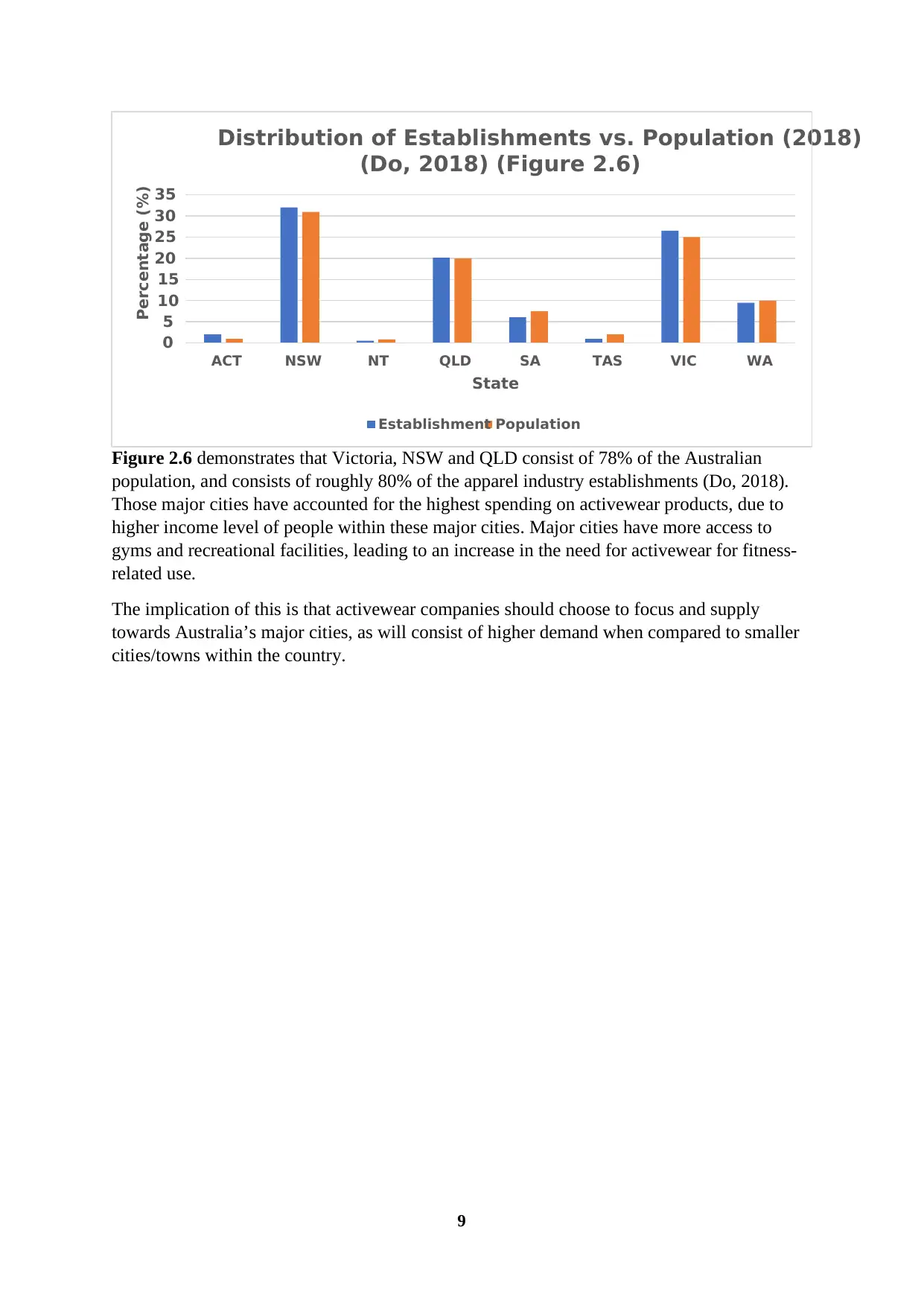
9
Figure 2.6 demonstrates that Victoria, NSW and QLD consist of 78% of the Australian
population, and consists of roughly 80% of the apparel industry establishments (Do, 2018).
Those major cities have accounted for the highest spending on activewear products, due to
higher income level of people within these major cities. Major cities have more access to
gyms and recreational facilities, leading to an increase in the need for activewear for fitness-
related use.
The implication of this is that activewear companies should choose to focus and supply
towards Australia’s major cities, as will consist of higher demand when compared to smaller
cities/towns within the country.
0
5
10
15
20
25
30
35
ACT NSW NT QLD SA TAS VIC WA
Percentage (%)
State
Distribution of Establishments vs. Population (2018)
(Do, 2018) (Figure 2.6)
Establishment Population
Figure 2.6 demonstrates that Victoria, NSW and QLD consist of 78% of the Australian
population, and consists of roughly 80% of the apparel industry establishments (Do, 2018).
Those major cities have accounted for the highest spending on activewear products, due to
higher income level of people within these major cities. Major cities have more access to
gyms and recreational facilities, leading to an increase in the need for activewear for fitness-
related use.
The implication of this is that activewear companies should choose to focus and supply
towards Australia’s major cities, as will consist of higher demand when compared to smaller
cities/towns within the country.
0
5
10
15
20
25
30
35
ACT NSW NT QLD SA TAS VIC WA
Percentage (%)
State
Distribution of Establishments vs. Population (2018)
(Do, 2018) (Figure 2.6)
Establishment Population
⊘ This is a preview!⊘
Do you want full access?
Subscribe today to unlock all pages.

Trusted by 1+ million students worldwide
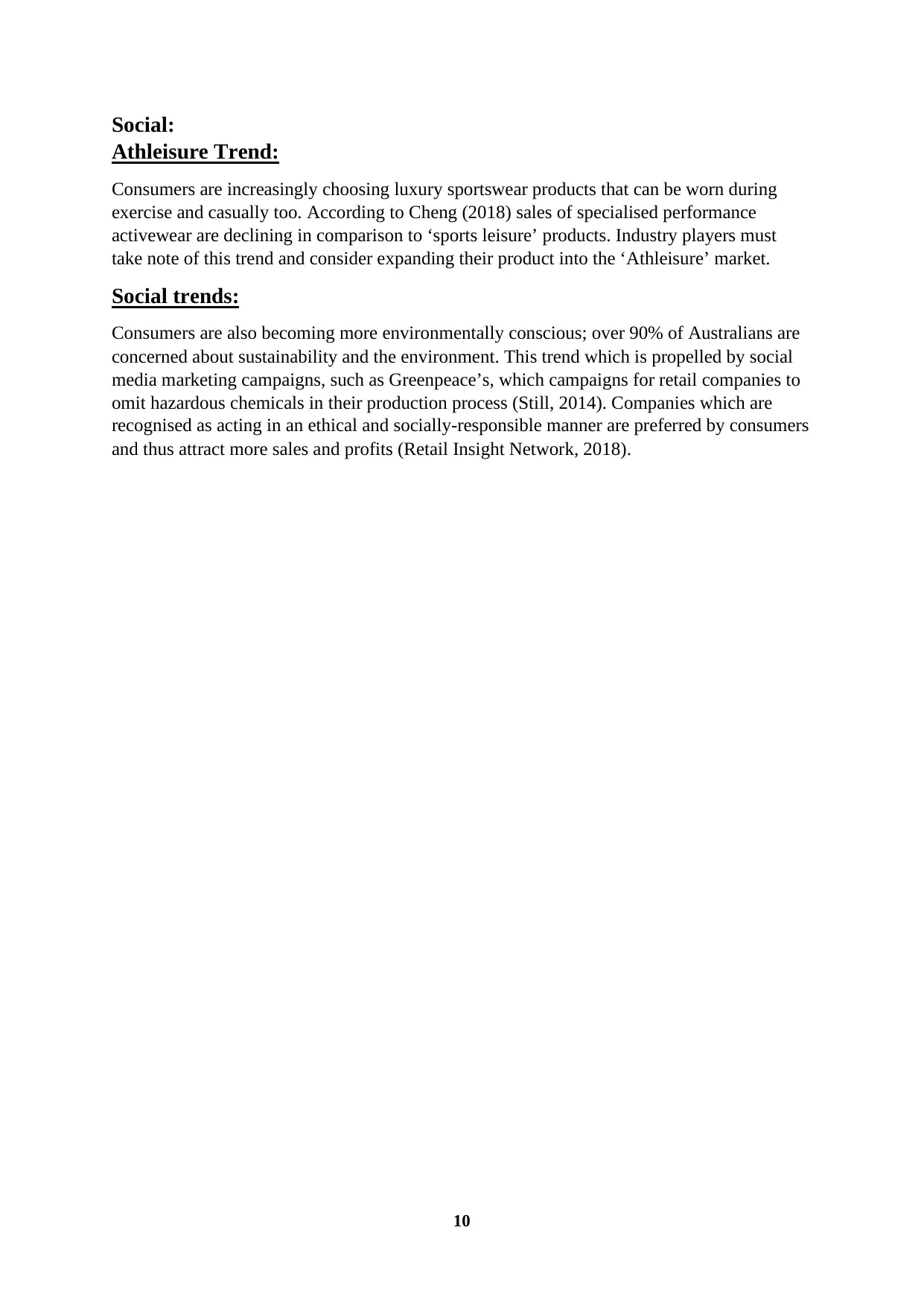
10
Social:
Athleisure Trend:
Consumers are increasingly choosing luxury sportswear products that can be worn during
exercise and casually too. According to Cheng (2018) sales of specialised performance
activewear are declining in comparison to ‘sports leisure’ products. Industry players must
take note of this trend and consider expanding their product into the ‘Athleisure’ market.
Social trends:
Consumers are also becoming more environmentally conscious; over 90% of Australians are
concerned about sustainability and the environment. This trend which is propelled by social
media marketing campaigns, such as Greenpeace’s, which campaigns for retail companies to
omit hazardous chemicals in their production process (Still, 2014). Companies which are
recognised as acting in an ethical and socially-responsible manner are preferred by consumers
and thus attract more sales and profits (Retail Insight Network, 2018).
Social:
Athleisure Trend:
Consumers are increasingly choosing luxury sportswear products that can be worn during
exercise and casually too. According to Cheng (2018) sales of specialised performance
activewear are declining in comparison to ‘sports leisure’ products. Industry players must
take note of this trend and consider expanding their product into the ‘Athleisure’ market.
Social trends:
Consumers are also becoming more environmentally conscious; over 90% of Australians are
concerned about sustainability and the environment. This trend which is propelled by social
media marketing campaigns, such as Greenpeace’s, which campaigns for retail companies to
omit hazardous chemicals in their production process (Still, 2014). Companies which are
recognised as acting in an ethical and socially-responsible manner are preferred by consumers
and thus attract more sales and profits (Retail Insight Network, 2018).
Paraphrase This Document
Need a fresh take? Get an instant paraphrase of this document with our AI Paraphraser
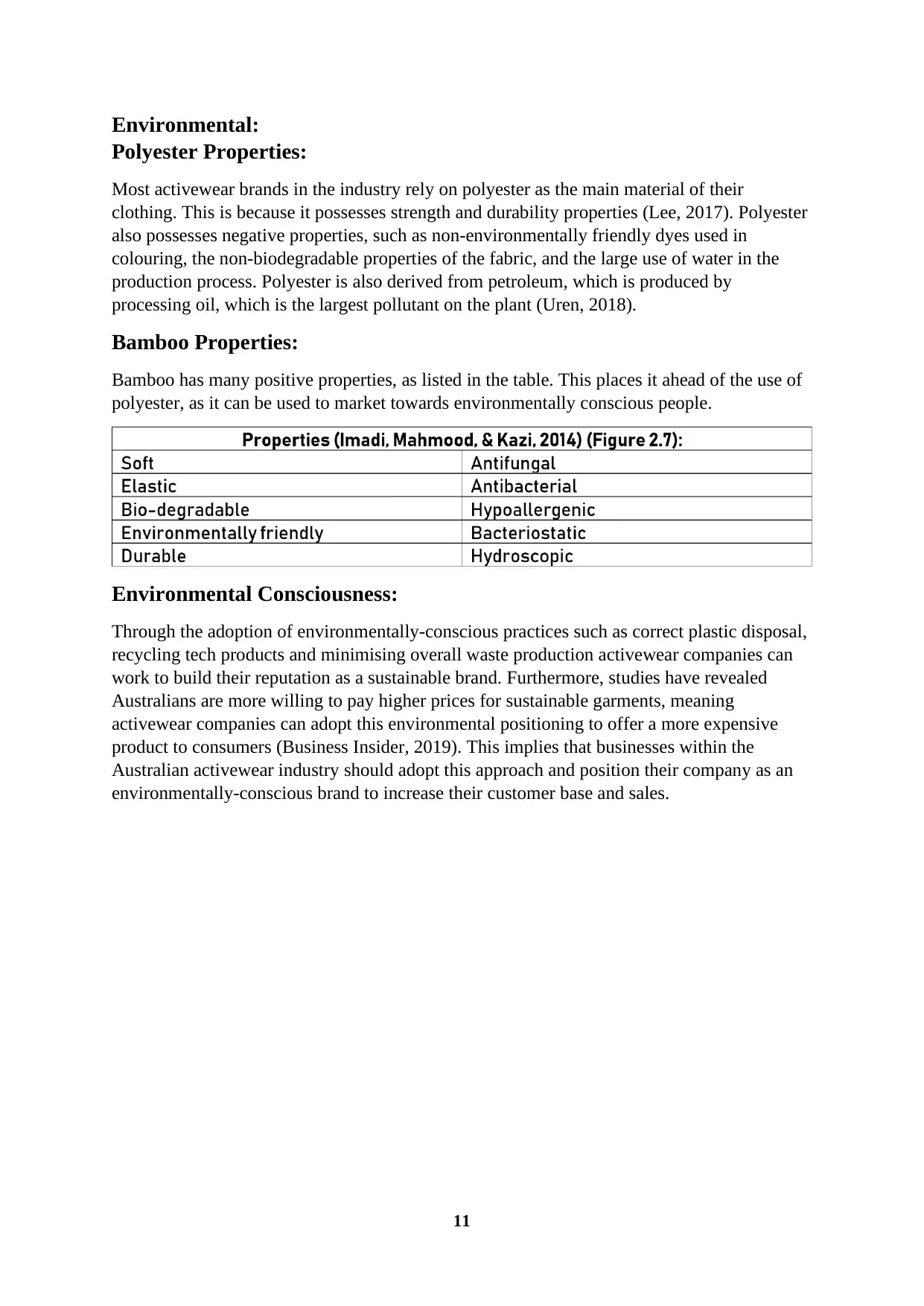
11
Environmental:
Polyester Properties:
Most activewear brands in the industry rely on polyester as the main material of their
clothing. This is because it possesses strength and durability properties (Lee, 2017). Polyester
also possesses negative properties, such as non-environmentally friendly dyes used in
colouring, the non-biodegradable properties of the fabric, and the large use of water in the
production process. Polyester is also derived from petroleum, which is produced by
processing oil, which is the largest pollutant on the plant (Uren, 2018).
Bamboo Properties:
Bamboo has many positive properties, as listed in the table. This places it ahead of the use of
polyester, as it can be used to market towards environmentally conscious people.
Environmental Consciousness:
Through the adoption of environmentally-conscious practices such as correct plastic disposal,
recycling tech products and minimising overall waste production activewear companies can
work to build their reputation as a sustainable brand. Furthermore, studies have revealed
Australians are more willing to pay higher prices for sustainable garments, meaning
activewear companies can adopt this environmental positioning to offer a more expensive
product to consumers (Business Insider, 2019). This implies that businesses within the
Australian activewear industry should adopt this approach and position their company as an
environmentally-conscious brand to increase their customer base and sales.
Environmental:
Polyester Properties:
Most activewear brands in the industry rely on polyester as the main material of their
clothing. This is because it possesses strength and durability properties (Lee, 2017). Polyester
also possesses negative properties, such as non-environmentally friendly dyes used in
colouring, the non-biodegradable properties of the fabric, and the large use of water in the
production process. Polyester is also derived from petroleum, which is produced by
processing oil, which is the largest pollutant on the plant (Uren, 2018).
Bamboo Properties:
Bamboo has many positive properties, as listed in the table. This places it ahead of the use of
polyester, as it can be used to market towards environmentally conscious people.
Environmental Consciousness:
Through the adoption of environmentally-conscious practices such as correct plastic disposal,
recycling tech products and minimising overall waste production activewear companies can
work to build their reputation as a sustainable brand. Furthermore, studies have revealed
Australians are more willing to pay higher prices for sustainable garments, meaning
activewear companies can adopt this environmental positioning to offer a more expensive
product to consumers (Business Insider, 2019). This implies that businesses within the
Australian activewear industry should adopt this approach and position their company as an
environmentally-conscious brand to increase their customer base and sales.
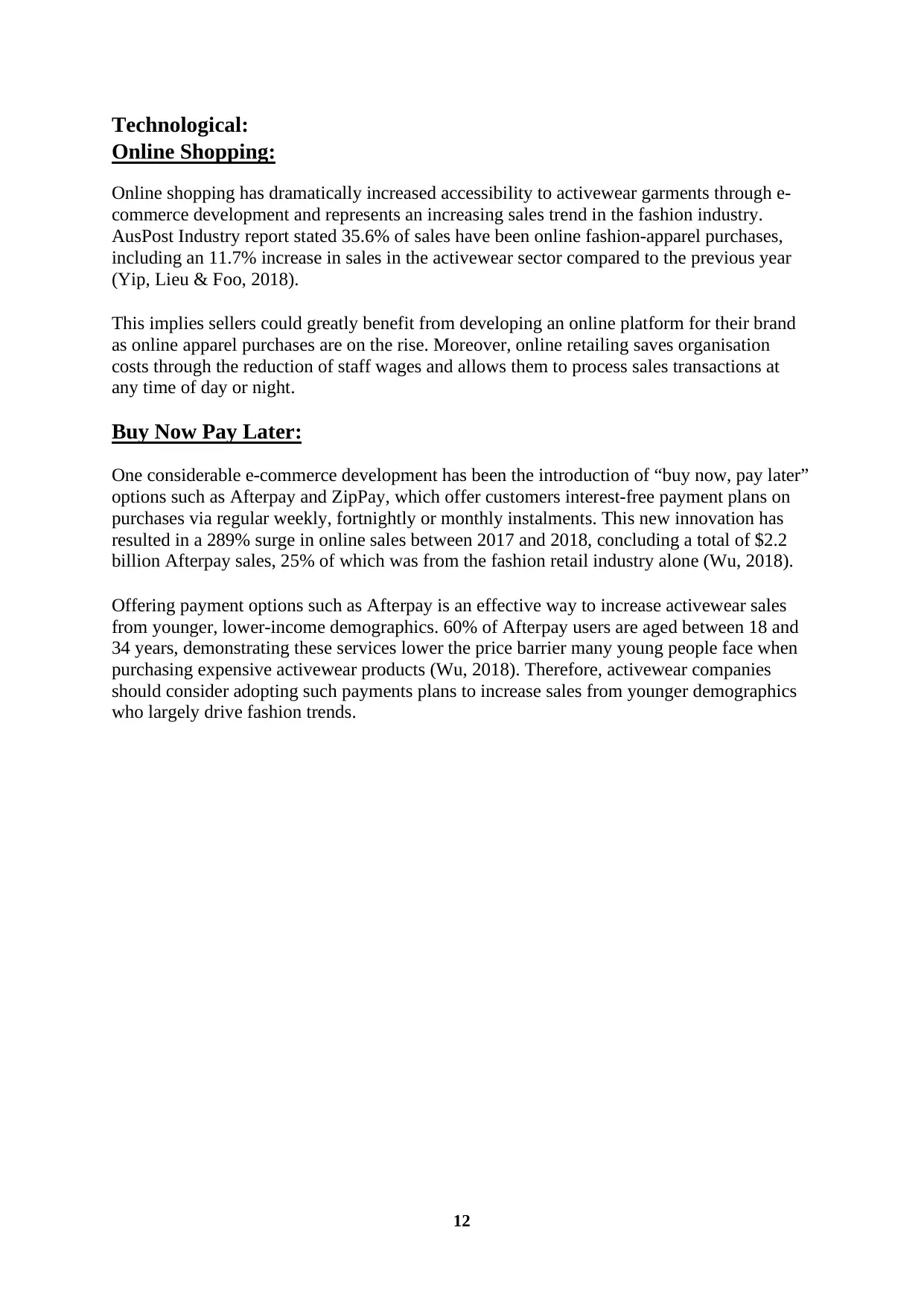
12
Technological:
Online Shopping:
Online shopping has dramatically increased accessibility to activewear garments through e-
commerce development and represents an increasing sales trend in the fashion industry.
AusPost Industry report stated 35.6% of sales have been online fashion-apparel purchases,
including an 11.7% increase in sales in the activewear sector compared to the previous year
(Yip, Lieu & Foo, 2018).
This implies sellers could greatly benefit from developing an online platform for their brand
as online apparel purchases are on the rise. Moreover, online retailing saves organisation
costs through the reduction of staff wages and allows them to process sales transactions at
any time of day or night.
Buy Now Pay Later:
One considerable e-commerce development has been the introduction of “buy now, pay later”
options such as Afterpay and ZipPay, which offer customers interest-free payment plans on
purchases via regular weekly, fortnightly or monthly instalments. This new innovation has
resulted in a 289% surge in online sales between 2017 and 2018, concluding a total of $2.2
billion Afterpay sales, 25% of which was from the fashion retail industry alone (Wu, 2018).
Offering payment options such as Afterpay is an effective way to increase activewear sales
from younger, lower-income demographics. 60% of Afterpay users are aged between 18 and
34 years, demonstrating these services lower the price barrier many young people face when
purchasing expensive activewear products (Wu, 2018). Therefore, activewear companies
should consider adopting such payments plans to increase sales from younger demographics
who largely drive fashion trends.
Technological:
Online Shopping:
Online shopping has dramatically increased accessibility to activewear garments through e-
commerce development and represents an increasing sales trend in the fashion industry.
AusPost Industry report stated 35.6% of sales have been online fashion-apparel purchases,
including an 11.7% increase in sales in the activewear sector compared to the previous year
(Yip, Lieu & Foo, 2018).
This implies sellers could greatly benefit from developing an online platform for their brand
as online apparel purchases are on the rise. Moreover, online retailing saves organisation
costs through the reduction of staff wages and allows them to process sales transactions at
any time of day or night.
Buy Now Pay Later:
One considerable e-commerce development has been the introduction of “buy now, pay later”
options such as Afterpay and ZipPay, which offer customers interest-free payment plans on
purchases via regular weekly, fortnightly or monthly instalments. This new innovation has
resulted in a 289% surge in online sales between 2017 and 2018, concluding a total of $2.2
billion Afterpay sales, 25% of which was from the fashion retail industry alone (Wu, 2018).
Offering payment options such as Afterpay is an effective way to increase activewear sales
from younger, lower-income demographics. 60% of Afterpay users are aged between 18 and
34 years, demonstrating these services lower the price barrier many young people face when
purchasing expensive activewear products (Wu, 2018). Therefore, activewear companies
should consider adopting such payments plans to increase sales from younger demographics
who largely drive fashion trends.
⊘ This is a preview!⊘
Do you want full access?
Subscribe today to unlock all pages.

Trusted by 1+ million students worldwide
1 out of 28
Related Documents
Your All-in-One AI-Powered Toolkit for Academic Success.
+13062052269
info@desklib.com
Available 24*7 on WhatsApp / Email
![[object Object]](/_next/static/media/star-bottom.7253800d.svg)
Unlock your academic potential
Copyright © 2020–2025 A2Z Services. All Rights Reserved. Developed and managed by ZUCOL.





